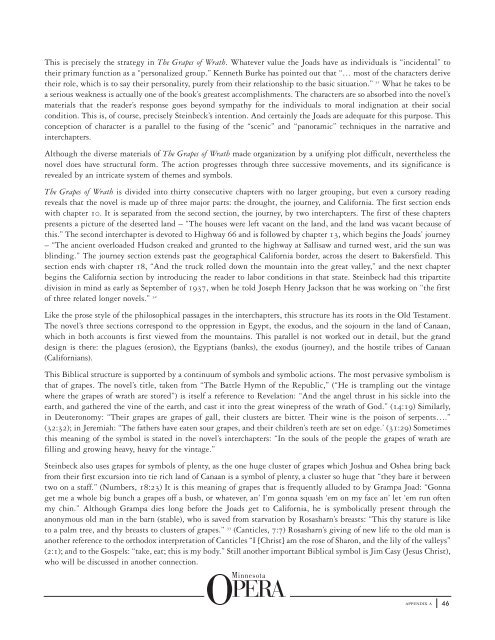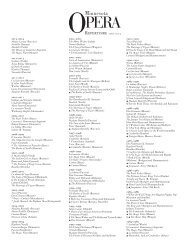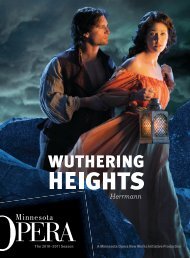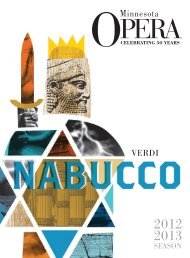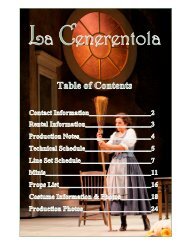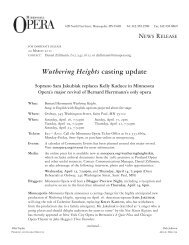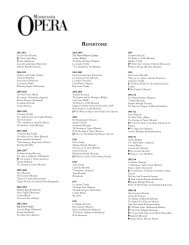You also want an ePaper? Increase the reach of your titles
YUMPU automatically turns print PDFs into web optimized ePapers that Google loves.
This is precisely the strategy in The <strong>Grapes</strong> of Wrath. Whatever value the Joads have as individuals is “incidental” to<br />
their primary function as a “personalized group.” Kenneth Burke has pointed out that “… most of the characters derive<br />
their role, which is to say their personality, purely from their relationship to the basic situation.” 31 What he takes to be<br />
a serious weakness is actually one of the book’s greatest accomplishments. The characters are so absorbed into the novel’s<br />
materials that the reader’s response goes beyond sympathy for the individuals to moral indignation at their social<br />
condition. This is, of course, precisely Steinbeck’s intention. And certainly the Joads are adequate for this purpose. This<br />
conception of character is a parallel to the fusing of the “scenic” and “panoramic” techniques in the narrative and<br />
interchapters.<br />
Although the diverse materials of The <strong>Grapes</strong> of Wrath made organization by a unifying plot difficult, nevertheless the<br />
novel does have structural form. The action progresses through three successive movements, and its significance is<br />
revealed by an intricate system of themes and symbols.<br />
The <strong>Grapes</strong> of Wrath is divided into thirty consecutive chapters with no larger grouping, but even a cursory reading<br />
reveals that the novel is made up of three major parts: the drought, the journey, and California. The first section ends<br />
with chapter 10. It is separated from the second section, the journey, by two interchapters. The first of these chapters<br />
presents a picture of the deserted land – “The houses were left vacant on the land, and the land was vacant because of<br />
this.” The second interchapter is devoted to Highway 66 and is followed by chapter 13, which begins the Joads’ journey<br />
– “The ancient overloaded Hudson creaked and grunted to the highway at Sallisaw and turned west, arid the sun was<br />
blinding.” The journey section extends past the geographical California border, across the desert to Bakersfield. This<br />
section ends with chapter 18, “And the truck rolled down the mountain into the great valley,” and the next chapter<br />
begins the California section by introducing the reader to labor conditions in that state. Steinbeck had this tripartite<br />
division in mind as early as September of 1937, when he told Joseph Henry Jackson that he was working on “the first<br />
of three related longer novels.” 32<br />
Like the prose style of the philosophical passages in the interchapters, this structure has its roots in the Old Testament.<br />
The novel’s three sections correspond to the oppression in Egypt, the exodus, and the sojourn in the land of Canaan,<br />
which in both accounts is first viewed from the mountains. This parallel is not worked out in detail, but the grand<br />
design is there: the plagues (erosion), the Egyptians (banks), the exodus (journey), and the hostile tribes of Canaan<br />
(Californians).<br />
This Biblical structure is supported by a continuum of symbols and symbolic actions. The most pervasive symbolism is<br />
that of grapes. The novel’s title, taken from “The Battle Hymn of the Republic,” (“He is trampling out the vintage<br />
where the grapes of wrath are stored”) is itself a reference to Revelation: “And the angel thrust in his sickle into the<br />
earth, and gathered the vine of the earth, and cast it into the great winepress of the wrath of God.” (14:19) Similarly,<br />
in Deuteronomy: “Their grapes are grapes of gall, their clusters are bitter. Their wine is the poison of serpents….”<br />
(32:32); in Jeremiah: “The fathers have eaten sour grapes, and their children’s teeth are set on edge.’ (31:29) Sometimes<br />
this meaning of the symbol is stated in the novel’s interchapters: “In the souls of the people the grapes of wrath are<br />
filling and growing heavy, heavy for the vintage.”<br />
Steinbeck also uses grapes for symbols of plenty, as the one huge cluster of grapes which Joshua and Oshea bring back<br />
from their first excursion into tie rich land of Canaan is a symbol of plenty, a cluster so huge that “they bare it between<br />
two on a staff.” (Numbers, 18:23) It is this meaning of grapes that is frequently alluded to by Grampa Joad: “Gonna<br />
get me a whole big bunch a grapes off a bush, or whatever, an’ I’m gonna squash ‘em on my face an’ let ‘em run often<br />
my chin.” Although Grampa dies long before the Joads get to California, he is symbolically present through the<br />
anonymous old man in the barn (stable), who is saved from starvation by Rosasharn’s breasts: “This thy stature is like<br />
to a palm tree, and thy breasts to clusters of grapes.” 33 (Canticles, 7:7) Rosasharn’s giving of new life to the old man is<br />
another reference to the orthodox interpretation of Canticles “I [Christ] am the rose of Sharon, and the lily of the valleys”<br />
(2:1); and to the Gospels: “take, eat; this is my body.” Still another important Biblical symbol is Jim Casy (Jesus Christ),<br />
who will be discussed in another connection.<br />
appendix a<br />
46


